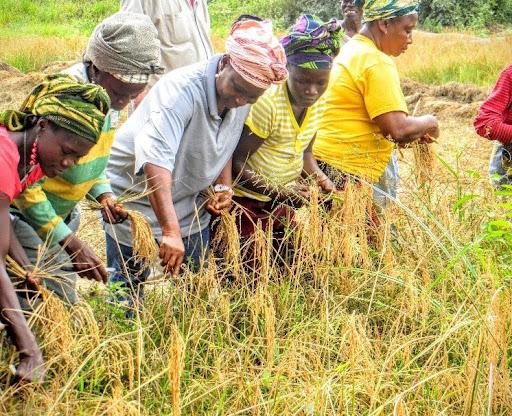Pres. Weah’s Agriculture Initiatives: How Can It Impact the Sector?

Flashback: Women farmers in Liberia harvest rice during the US$ 75 million USAID supported agriculture project.
President George M. Weah pronounced agriculture as a priority for the development of the country and the sustenance of peace since he became a leader. But what it takes to make his vision for agriculture a reality is something that one may somewhat wonder. His pronouncement to improve agriculture is being mentioned in several annual messages he had delivered to the Joint session of legislature. It is also enshrined in the country’s development agenda, the Pro Poor Agenda for Prosperity and Development (PAPD).
Agriculture accounts for more than 60 percent of the country’s workforce, and, if prioritized, can reduce poverty in the lives of the citizens, ensure employment opportunities as well as improve food security.
Nevertheless, despite the vast opportunities agriculture creates for investment in the country’s economy, allocation in the national budget for agriculture is still not encouraging. Funding for the sector under President Weah’s administration remains minute, except monies that derive from external sources, such as the World Bank, African Development Bank, International Fund for Agricultural Development (IFAD), the European Union and other developmental partners.
In the 2020-2021 national budget, 2 percent of the total budget was allocated toward Agriculture. Imagine, almost two decades later, Liberia, a signatory to the Malabo Declaration for Food and Nutrition Security, is yet to commit 10 percent of its national budget annually toward agriculture? This is something some officials of the current administration have attributed to the government’s failure due to competing national priorities that still confront the country. For many years after receiving more developmental assistance, are we still talk about competing priorities? Why are we speaking of using agriculture to diversify the economy?
The agricultural sector still faces challenges, even with increased investment, attracted during former President, Madam Ellen Johnson’s administration to revitalize the sector. During Madam Sirleaf’s 12-year presidency, about 16 major agriculture projects were attracted by her government to transform agriculture and fisheries. USAID was the largest donor, providing US$ 75 million dollars to support agriculture, under its Feed the Future program.
Yet, still, in furtherance of agricultural transformation, President Weah, is striving to demonstrate his commitment in the fourth year of his administration by attracting a few projects.
Some projects that currently support smallholder farmers under the Weah’s administration, are the Smallholder Agriculture Transformation Agribusiness Revitalization Project (STAR-P), and the International Fund for Agricultural Development (IFAD). Just recently, the government signed three major agriculture projects worth US$72 million dollars with its international partners.
Those projects, when rectified by the Liberian Legislature, will support farmers in various food value chains, improve farm to market roads, address the issue of climate change and promote access to loans for smallholder farmers.
Additionally, the government, with support from UNDP, recently introduced a new project ‘Livelihood and Jobs Creation’ that aims at supporting youth and women in agribusinesses and other petty trading businesses to mitigate the impact of the global pandemic. Also, the President, in 2018, travelled to the United Arabs Emirates (UAE) and pleaded with the government of the country, for investment in the various sectors of the economy, including, agriculture, energy etc. Out of the development assistance, 2.5 million euros was allotted for agriculture to increase crop production in four counties.
Interventions of such agriculture projects by President Weah are welcoming for smallholder farmers and other actors of the agricultural value chain as well as stakeholders. However,, the implementation of those major projects is what matters most. Will the identification of beneficiaries be as business as usual, where the real farmers are not chosen for assistance? Also, will the Ministry of Agriculture make sure that the intervention of the various projects holistically address those needs in the sector, rather than addressing the issues of purchasing expensive vehicles and providing fabulous salaries and other benefits for workers? Those were some shortcomings of the previous agricultural interventions.
Liberia has gone too far with the issues of agricultural transformation. With the amount of money that has come into agriculture as support to farmers, should by now make the country less dependent on food imports. Why should Liberia still spend US$200 million annually to import rice, when we had projects that lasted for five years to reduce rice imports? One of such projects is the West Africa Agriculture Productivity Program (WAAPP) a US$14 million Japanese World Bank supported project implemented to reduce rice imports and improve smallholder rice farmers’ incomes, thereby to improve food security.
Most previous interventions are reported not sustainable, thus causing many smallholder farmers to still struggle in farming. If we are to realize the outcomes of President Weah’s agriculture initiatives, the Ministry of Agriculture, under the leadership of Minister Jeanine Milly Cooper, who has been praised highly by the President for excellent performance in ensuring that his vision becomes a reality must do things differently. She must ensure that beneficiaries of agricultural programs are assisted based on their potentials and not connections. The Minister must also make sure that adequate support reaches farmers. More, just needs to be done in terms of better budgetary allotment for agriculture and transparency in the sector, if we are to attain agricultural transformation.
